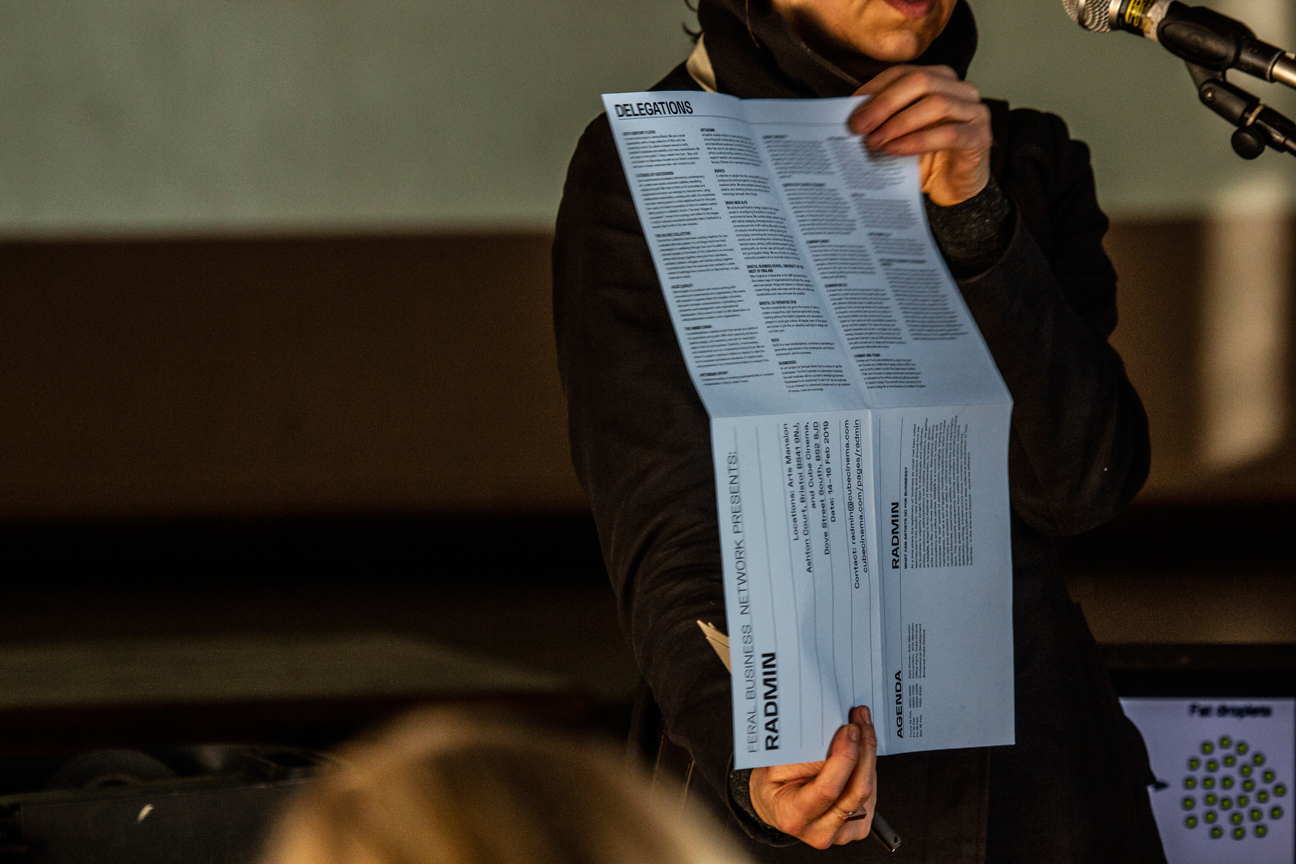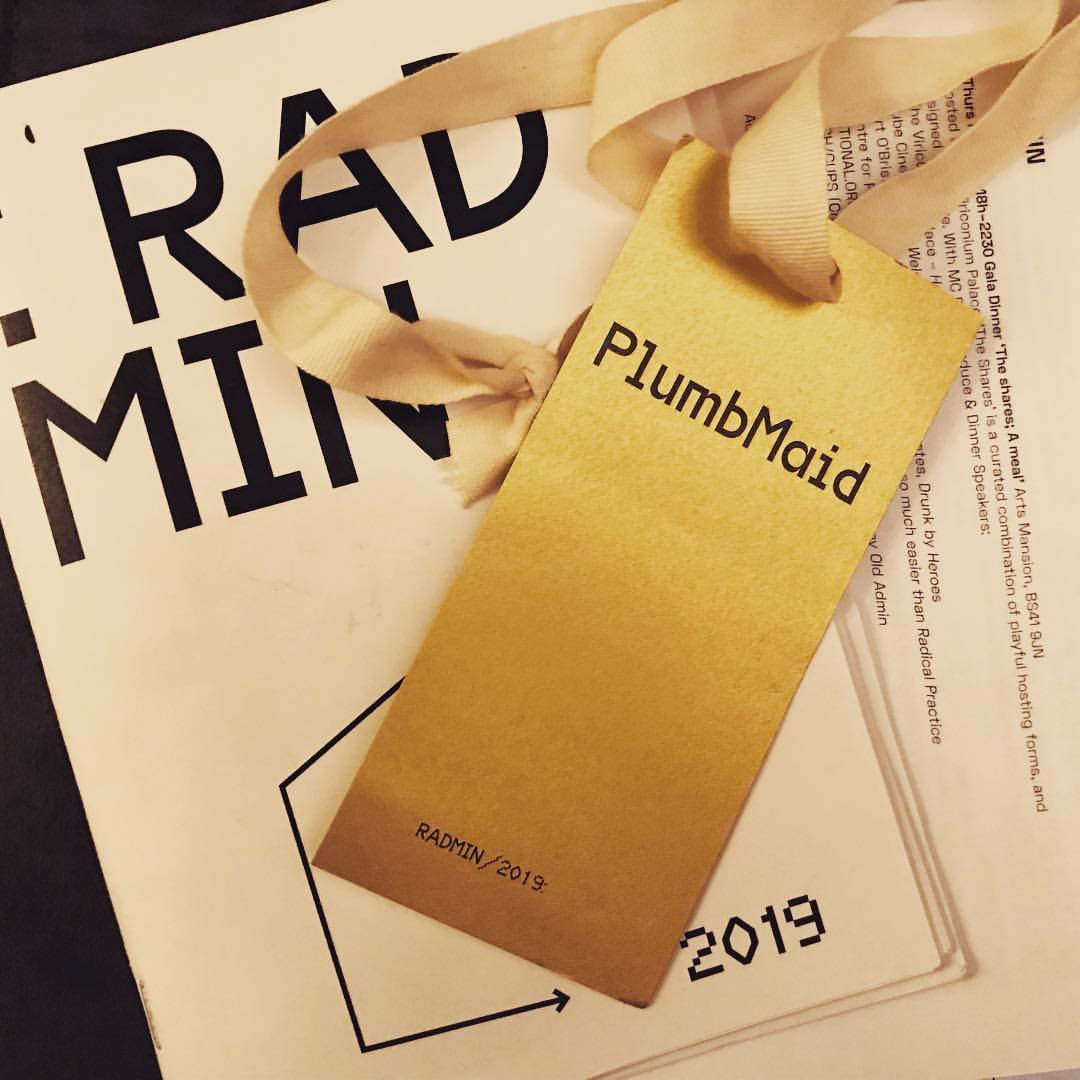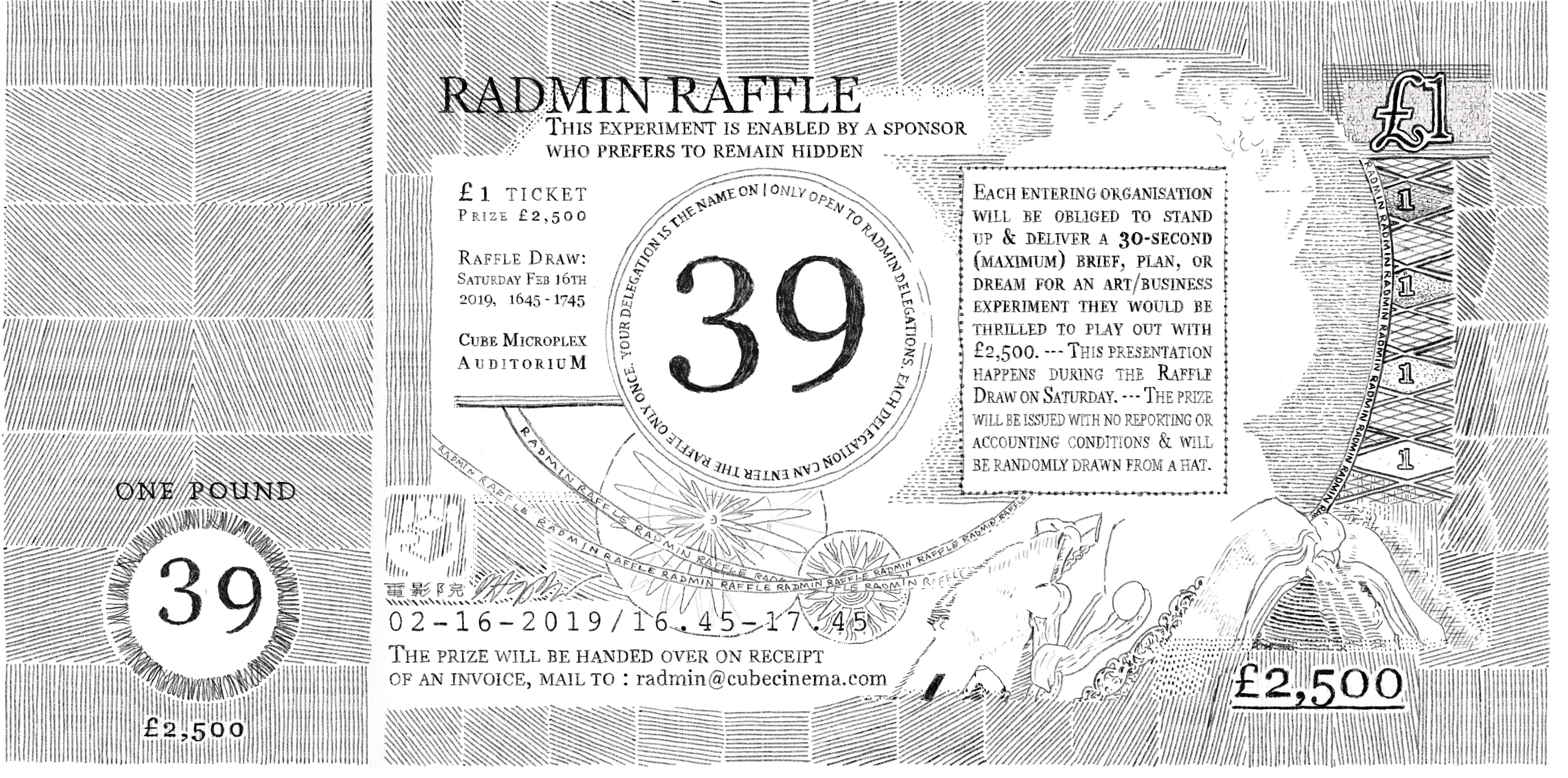This is an old revision of the document!
post-RADMIN reflections
Objectives
The ember of thinking behind RADMIN was less a curatorial venture than throwing up a tracer or perhaps lighting a bonfire, to illuminate what is out there, &/or who/what would be drawn to the prospect of a festival of Administration. The topic of administration represents only a sub-category of the larger enquiry into how we might do business differently. But by nature being urgent, common, everyday (yet curiously segregated when it comes to creative practice), enveloping of both individual and collective situations (while going often unspoken / unacknowledged in each), socially awkward and determinedly anti-spectacular, it seemed like a good place to start.
RADMIN was devised and delivered over a run-up of 4 months by a core team of two, alongside many others from our larger collectives the long-standing Cube Microplex, the recently assembled Feral Business Network and the nascent Institute for Experiments with Business (Ibex). The process represented a rapid materialisation of some decades of thinking. For me it was a space to lay out a tangle of burning questions, such as,
- What can artists do for business?
- Why leave the experiments to Silicon Valley?
- How and where to collide the wealth of indigenous thinking from art with the intractable problems of business as usual?
and in the longer run,
- How to speak back into the spaces of business and enterprise with radically new business shapes for a genuinely sustainable economy?
To put these ambitions in perspective, RADMIN should be understood as an initialising event in a 20-year+ endeavour whose objectives include
- To break down some of the consolidating associations of business and open up this territory to exploration;
- To reconsider the 'dull' spaces of administration as not just something we are subject to but a site for politics, solidarity and change;
- (In relation to art) to extend a critical and experimental attention from content to containers: the infrastructures in which the art work takes place;
- To assemble diverse experiments with business in this realm, alongside a vocabulary for naming them together (could these practices already constitute an economy?)
- At the same time, to provoke, dislodge or at least carefully consider the litany of scarcity in artist livelihoods - and consider how the above work might be better leveraged to resource us.
- And most likely as contentious, to invite thinking about business and economy at a psychological level into contexts where this approach is not always welcomed or trusted, bringing political autonomy, psychology, spectacle and modes of organisation into probable collision.
RADMIN was also and specifically a festival in, of and about the Cube Cinema, crucible of much of this thinking. The Cube is programmed, staffed and governed on an ad hoc basis by approximately 150 volunteers. A foundational intention for RADMIN was to open out the infrastructure, processes and organisation of the organisation, how it is managed and administered, as programme content. An internal operating memo in the form of a festival.
Another more practical trigger was the Feral Business Research Network (FBRN) a proposed academic networking project for artists thinking with business, that despite being unselected for research funding played out anyway across two workshop gatherings in London and Rovereto, Italy in 2018. RADMIN was the third and final network-building event in this series.
Production
The festival format loosely followed a rapid fire structure wherein a volley of short events would act as diverse triggers for thinking, each item lasting not much over an hour, after which participants could be pinballed in another direction, with the surrounding space to strike up new connections and conversations. A scattershot approach, opening on the first evening with a Gala Dinner and a series of 3.5 minute dinner speeches to cast the terrain of what might be considered administration wide (the business school, trade and logistics, monetary experiments, hitchhiking, heritage, plumbing and radical art history).
The Day Two Convention was arranged as a more conventional series of workshops, followed by an Office Party at the Cube. Day Three opened out into delegate-generated content with the Professional Development Bonanza!, radio show, raffle and Trade Show at the Cube, and Staff training session before closing with the reassuringly familiar format of a feature film.
Participation
The programme aimed to work both as both a dragnet and a filter, to invite in a broad constituency of interests and gauge where the concentrations and intensities might lie. In the end, the event swiftly self-marketed along ley lines of association, as rapid word of mouth ticket sales kept attendance almost entirely within existing networks (even if as far flung as Malta, Serbia and Hong Kong). This made for an unplanned constraint and the fear of being wedding-like was on our minds. However I would be cautious to describe these interlocking networks as homogeneous or coherent - even bringing an art crowd together with the Cube staff/audiences made for an unwieldy and effective collage.
Most delegations took up the invitation to register as organisations and many attended in pairs or small groups, although some registered under their own names as self-employed business entities. Delegates were asked to submit an organisational bio, which appeared on their lanyards, and together made up the printed programme, the event's main treasure.
Organising through a RADMIN lens
The container of RADMIN had the upside of rendering the usual stumbling blocks and dull administrative grooves vivid and poignant, even if just a performance to ourselves. This included getting caught in each others' spam filters, the online ticket-seller software hardcoding Valentine's Day into the event description, and our out of business hours email habits triggering a starburst of out of office autoresponders. Questions of how to be handbuilt and powerful were vividly rendered in the sub-project of the RADMIN reader, a zine-like collection of short texts and DIY endeavour by design. Graphics students from the University contributed the design and layout as part of their professional practice module. However when it came to print, fold and staple, not passing the 70-unit job over to University Print Services (a design decision) caused an operating logjam played out in the art department printer queue, where I spent almost two entire days negotiating with (supportive) IT technicians, network log-in protocols, office supply enclaves, line-management protocols, (irate) institutional hierarchies, beneficial staplers and the whole situated process of production which was really the entire point.
Logistics
Working across two venues served to extend the concept of the Cube, its operations, administration and self-image, well beyond the building. It also stretched our organising capacity and human energies to the hilt. As a determinedly all-volunteer workforce, preparation and delivery of the event was woven into and around other occupations: painting and decorating, studying, lecturing, telephone sales, archiving, public speaking, parenting and not ironically admin roles.
The Money
While RADMIN steered away from economy as its main focus, money surfaced with persistence in the programme as an organising technology. Of which to observe,
I The budget is the content. The budget was both an organising input and a featured artwork at the event, printed and distributed as an A3 poster. In accordance with the economy of the Cube, the event was run entirely on ticket sales, supplemented with substantial personal/organisational resources. Budget decisions (keeping ticket prices low, not paying fees to the many contributors/presenters and not seeking project funding) were central to the event design.
II The festival was designed to demo a wealth of resources, counter to a litany of monetary scarcity that surges through many conversations in the arts (as elsewhere). These included a feast, a mansion, several outbursts of cash and the richness of innumerable projects and lives' works. In the end, life rather than money loomed over the programme as the scarce resource, as a slew of health-related events caused a number of last minute cancellations and re-orderings. Conversely two days of brilliant winter sun set the scene well beyond our ability to stage-manage.
III The Viriconium Palace money experiment, which opened the festival, inflected proceedings more than expected. The reactions, some of them quite strong ran a pervasive seam of charge and disturbance throughout 3-day gathering.
IV The Business Experiment Raffle, announced at the gala dinner: a raffle with one ticket available to each RADMIN delegation. A manouever in dissociative funding. Entry was gated by requirement to be present at the Day 3 Raffle Draw, where each entrant was obliged to deliver a 30-second plan or dream for a business experiment to the assembled room, after which the £2,500 prize was randomly drawn and issued to the winner with no strings attached.
After thoughts
From the hindsight of an array of debriefings, the following points came into focus.
There was something enabling about the event that encouraged many to feed back their reactions and highly individual criticisms in great detail!
This might reflect a determinedly decentring impulse in the event organisation, where organisers (both from RADMIN and The Viriconium money experiment) did not seek to issue explanations or reassuring commentary. A source of both discord and generative insights all round.
A general division in reception. Many attendees reported feeling fed with a dazzling array of inspiring inputs while for others - primarily those thinking for decades in these areas already - that the programme was nowhere near hard, deep or business enough, crystallising a desire for deeper work to follow. This also provokes questions of: how to still speak to the street / bring in business / not alienate those already 20 years in to the the process / and still keep the peripheries open.
A general request: for more takeaway actions, radmin tips and tricks to apply for life. More administrators and fewer artists!
How to engage (or not) with lines of conversation that circled back to 'privilege', 'struggle', ' exploitation', 'clique' and money. And how the psychological/ spiritual level may trip up politics (and aesthetics) and how that collision could be managed/valued.
How to get the right kinds of diversity in the room, in recognition of the different forms diversity can take, while still not stretching the consensus so far as to breach the possibilities of real communication, Recognising how deeply embedded assumptions about 'art' and 'business' are.
A programme constituted by actual research - rather than content delivery for an audience - is contributory also in that where it fails to work smoothly, it offers up opportunities for collective learning. Along similar lines, radical decentring as an organising technique, instinctively adopted by RADMIN organisers (in part through experience from running the Cube), will throw people off balance but likewise opens up real space for conversation.
Next steps
Having seen who a bonfire-lighting approach brings in, how to organise the next stage of the conversation.
A switch from a network/spectacle phase to deeper workgroups for day long investigations. Potential schedule: A 3-5 day event in Summer 2020. Lines of enquiry to include:
a) Legal b) Administrative c) Vegetal d) Pscyhological / coaching e) Enterprise imaging f) Creative accounting (not present at RADMIN, but critical) g) Activities for translating administrative thinking into other realms (personal training, hitchhiking etc) h) And critically the role of artist/practitioner in all this. How to both be resourced and have agency, which brings themes of scarcity and abundance questions together. Lines of enquiry from RADMIN that lead into this include the artist-tradesperson double identity (PlumbMaid, Feral Trade), the history of the Incidental Person from APG, and an understanding of the value the art practitioner in a interdisciplinary research context.
An immediate task to organise around, the post-RADMIN reader.
Assemble the raffle pitches
An annual retreat
An annual counter-capital raffle!



